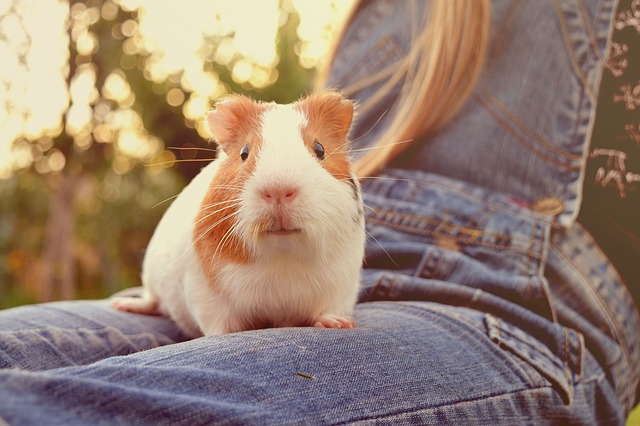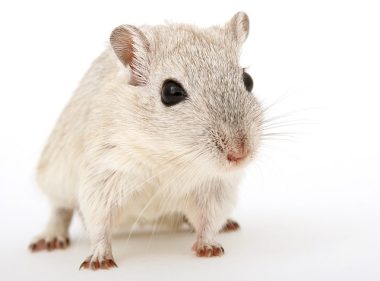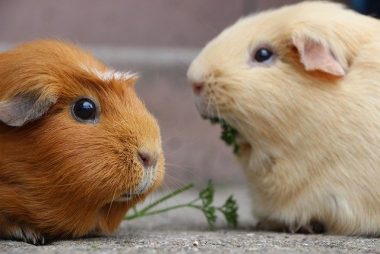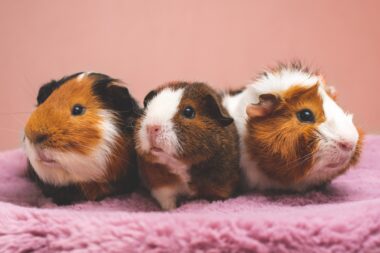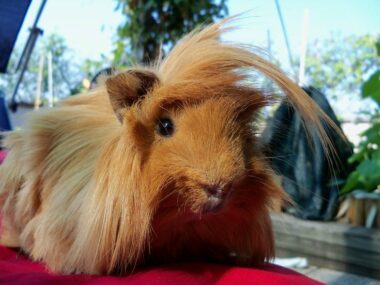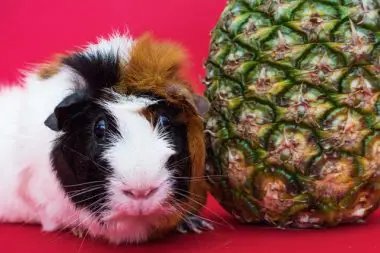Guinea pigs have been domesticated over a period of time to become one of the most popular household pets. They are gentle, docile, and sensitive creatures and make for loving household pets for both adults and children. They are easy to care for and are quite sociable, making them a popular pet with families who have young children.
The curiosity and excitement associated with getting a new guinea pig into your home mean that at some point you will want to interact with and hold your furry friend. Despite being sociable and friendly creatures when they gain your trust, some caution must be exercised on how to hold a guinea pig. This is true if you have just brought your furry friend home. You will need to gain your guinea pig’s trust before holding him. With time, patience, and some good tips to ensure the least stress for your pet and yourself, you will be able to gently hold your guinea pig in no time. This article aims to equip you with just the right skills and tips on how to hold a guinea pig.
Do Guinea Pigs Like to be Held?
Guinea pigs are highly sensitive and delicate creatures. They have delicate bones and sensitive inner organs that must be handled with care. You must remember that although domesticated, guinea pigs are at the bottom of the food chain in the wild. They are predated upon by larger carnivores and omnivores. They have developed a naturally strong flight response and are fearful and wary of their surroundings. For this reason, you must learn to gain the trust of your guinea pigs before you hold them.
Since being carried is not natural for guinea pigs, their fight or flight response will kick in, especially when trying to hold a new guinea pig. The guinea pig will either freeze or will try to escape when they sense a threat. You must approach guinea pigs with caution, gain their trust and ensure they are in a safe and stress-free environment before you try to hold them. It is always best to handle guinea pigs that are used to being held, petted, and groomed. Nonetheless, with a some patience and practice, you can learn how to hold a guinea pig safely.
How to Hold a Guinea Pig Safely?
Guinea pigs can become easily stressed with excessive handling or being held for extended periods of time. Ensure that you start small and gradually build up the amount of time you spend holding your guinea pig. Your guinea pig’s cage or enclosure must be kept in a safe, secure, and noise-free environment. Guinea pigs can be easily startled by loud and sudden noises. So ensure that their enclose is in a quiet, well-lit, and well-ventilated space.
Give your new guinea pig a few days to get accustomed to its new environment. Then you can gradually introduce yourself. Allow your guinea pig to grow accustomed to your smell. Offer your hand in its cage and let it smell you. You can gradually start gently petting your guinea pig on the head in between its ears. A guaranteed way to build your little furry companion’s trust in you is to offer treats. Lots of treats! Guinea pigs love to munch on some delicious treats. Keep some carrots, lettuce, or blueberries at hand. Your guinea pig will start to eat out of your hand and see you as a source of food and comfort, rather than a threat.
The following steps will help you hold a guinea pig safely and confidently!
1. Keep a towel ready for any instances of poop or pee.
2. Be calm and approach your guinea pig’s enclosure from the front. Let your guinea pig smell you as you gently pet him between the ears.
3. Use your guinea pig’s cage to your advantage, especially if you have installed some exercise pipes in there. Gently guide your guinea pig into one of the pipes or its nesting home in the enclosure. Put your hand out to encourage your guinea pig to come out. If using the pipe, ensure the other end of the pipe is blocked so that your guinea pig doesn’t escape.
4. Once you have a hold of your guinea pig, put one hand or palm under or around the chest of the guinea pig. Slip a finger around the front of one of your guinea pig’s front legs to secure your pet.
5. Use your other hand or palm to lift and support its bottom and hind legs. Always use both your hands to hold a guinea pig.
6. Hold your guinea pig close to your body or near your chest in a cupping motion to help your pet feel more secure and steady in your arms.
7. Guinea pigs should be held with both arms close to your chest with their feet towards your body. Alternately, they can be laid across your forearm with one hand stroking their back or head.
8. Hold the guinea pig firmly, but gently. Be cautious to ensure that you do not hold or squeeze your pet too hard. Guinea pigs have extremely sensitive spines and bones.
9. Take care to avoid any sudden sounds or movements that can scare your guinea pigs. Guinea pigs do not like to be held too high off the ground. Ensure you are sitting on the floor or near the ground when holding a guinea pig.
10. If your guinea pig starts to wriggle or struggle, do not let go as the guinea pig will jump off and hurt itself. Instead, lower yourself or move towards the door of your guinea pig’s enclosure. Then let the guinea pig down into one of the pipes or its nesting space.
Always use treats to encourage petting and building trust in your guinea pig. Talk to your pet in a gentle and soothing voice to reduce their fear and wariness of you. These tips will help you hold your guinea pig safely in no time provided you take the time and patience to build a safe and secure bond between your pet and yourself.

How Long and How Often Should a Guinea Pig be Held?
Ideally, a guinea pig can be held and petted for a maximum of 10-15 minutes at a time to ensure that your pet does not get too distressed or overstimulated. Your guinea pig will let you know when it wants to be released into its cage. It will start to wriggle or get restless. Take care to ensure you lower yourself and your arms gently into the enclosure before releasing your guinea pig.
Guinea pigs will rarely poop or pee on you as you hold them. But it is best to keep a towel at hand to clean up in such instances.
The key to holding a guinea pig safely is consistency. Be consistent with holding and petting your guinea pig so that your pet gets used to you and starts to trust you. Most guinea pigs love to be gently petted on the head and under their chins. Be careful to avoid exerting too much pressure while holding your guinea pig.
When Should a Guinea Pig Not be Held?
Guinea pigs should not be handled excessively when they are newly born or unwell.
Newly born baby guinea pigs are extremely delicate. Their bones haven’t developed yet and it is important that you do not hold newly born baby guinea pigs. Newborns will be hidden in the mother’s nesting area for the first few weeks of their lives as they grow and develop. The mother will care for the newborns till they are ready to explore the nest further.
Mother guinea pigs who have just delivered must not be held too. This is an extremely sensitive period of the mother and handling her might cause her unnecessary stress or pain. It is best to wait until the mother recovers and is ready to interact with you again.
Guinea pigs who are unwell must have very limited and stress-free interaction. It is important for your unwell guinea pig to be examined by a good veterinarian doctor. In such cases, it is best to transport your guinea pig in a small box or crate to the veterinarian’s office. Limit handling as far as possible. Your little companion will return to its usual self once it starts feeling better.
How to Hold a Pregnant Guinea Pig?
Pregnant guinea pigs must be handled with care. It is important to take a pregnant guinea pig for regular veterinarian examinations. If possible, have your doctor visit home to minimize stress and handling. Hold the guinea pig as little as possible during late pregnancy. Pregnant guinea pig sows must be kept separate from males as well as female guinea pigs in a nursery built especially for delivery and post-delivery care. Take care that you do cause stress through excessive handling and ensure a steady supply of nutritious food and treats.
How to Hold a Guinea Pig? Tips for Young Children
When teaching young children how to hold a guinea pig, always supervise their interaction with your pets. It is best that children remain seated on the floor when interacting with a guinea pig. Do not allow young children to carry the guinea pig. Instead, let your guinea pig roam freely around your children as they learn to gain its trust through food and treats. Gradually, young children can pet and stroke the guinea pig gently. It is best to avoid young children carrying guinea pigs in their hands as the guinea pigs may jump or scramble from fear and hurt themselves.
Guinea pigs must be handled with care and caution at all times. As long as the pointers on how to hold a guinea pig safely are followed, you can be sure to enjoy holding and petting your pet companion. Guinea pigs are extremely sociable and will let you know when they are comfortable to be held. Guinea pigs who want to be held will trust you, follow you around, and accept food and treats from your hands. They will climb on you when you are seated and vocalize to indicate their comfort. Just be sure to exercise caution and hold them gently and you and your guinea pig will share a wonderful bond in no time!
